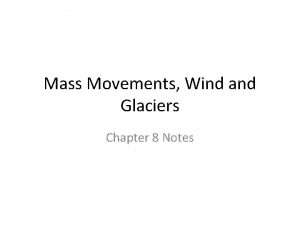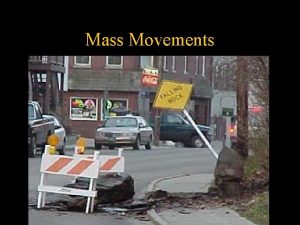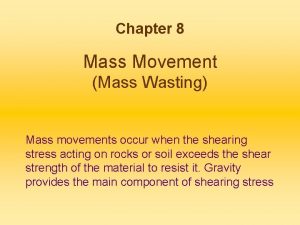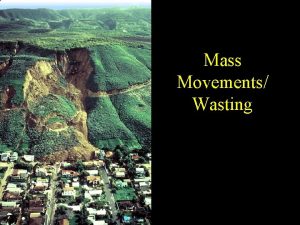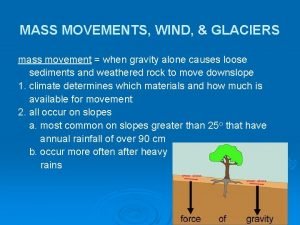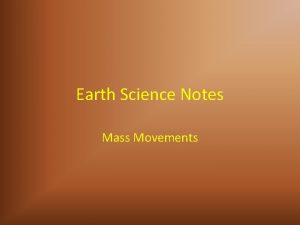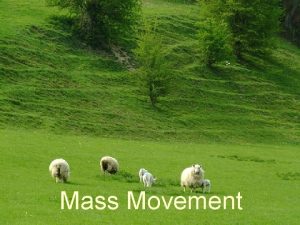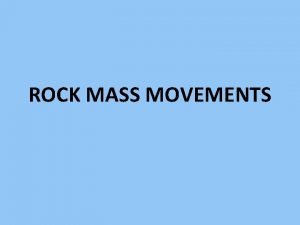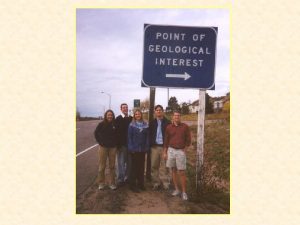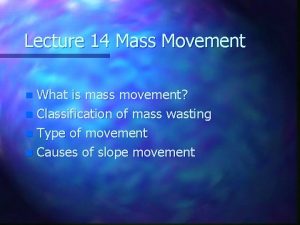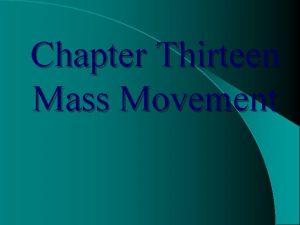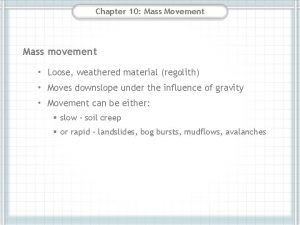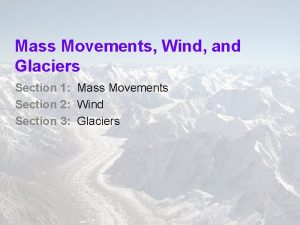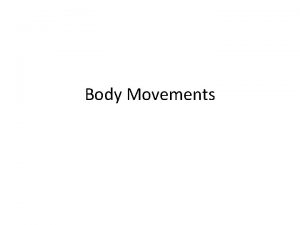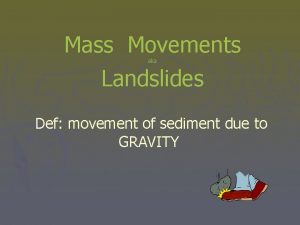Mass Movement Section 5 3 Mass Movements The






























- Slides: 30

Mass Movement Section 5. 3

Mass Movements • The transfer of rock and soil downslope due to gravity is called mass movement. – Ex: Landslides • The combination of weathering and mass movement produce most landforms. • Once weathering weakens and breaks rock apart, mass movement moves the debris downslope. • There a stream usually carries is away. • Stream valleys are the most common of Earth’s landforms.

Mass Movements • Several factors make slopes more susceptible to the pull of gravity. – – Saturation of surface materials with water. Oversteepening of slopes. Removal of vegetation. Earthquakes. 1. Water: • Heavy rains and rapid melting of snow can trigger mass movement by saturating surface materials with water. • When the pores in sediment become filled with water, the particles slides past one another easily.

Mass Movements 2. Oversteepened Slopes: • Loose soil particles can maintain a relatively stable slope up to a certain angle (25 to 40°), depending on the size and shape of the particles. • If the steepness of the slope exceeds the stable angle, mass movement is likely. • Such slopes are said to be oversteepened. • This can result when: A. Streams undercut a valley wall. B. Waves pound against the base of a cliff. C. People, through excavation during construction of roads/buildings.

Mass Movements 3. Removal of Vegetation: • Plants make slopes more stable because of their root systems. • When plants are removed, mass movements are likely. 4. Earthquakes: • Earthquakes are one of the most dramatic triggers of mass movements. • They can dislodge rock and unconsolidated material, which can cause more damage than the earthquake itself.

The process responsible for moving material downslope under the influence of gravity is called A. B. C. D. Erosion Weathering Mass movement Soil formation

What is the force behind mass movements? A. B. C. D. The Sun’s energy Flowing water Gravity Moving ice

Which of the following is not true about mass movements? A. Some mass movements are too slow to be seen. B. Mass movements always lead to landslides. C. Gravity is the driving force behind all mass movements. D. Mass movements are always downslope.

What factor commonly triggers mass movements? A. B. C. D. Saturation of surface materials with water. Earthquakes Removal of vegetation All of the above

Why can the removal of vegetation trigger mass movements? A. The soil loses nutrients and begins the crumble. B. The plant roots bind the soil and regolith together. C. The shaking triggers mass movements. D. The plant roots lubricate the loose sediment.

Oversteepened slopes often lead to mass movements because A. Plants cannot grow on them. B. The angle of their slope is between 10 and 20 degrees. C. The angle of their slope is less than 20 degrees. D. The angle of their slope is greater than 40 degrees.

During what season would you expect mass movements to be a greater threat? A. A dry summer. B. A wet spring before vegetation is growing. C. A wet spring with lots of growing vegetation. D. A dry autumn after the leaves have turned.

Mass Movements • Geologists classify mass movements based on the kind of material that moves, how it moves, and the speed of the movement. 1. Rockfalls: • Occurs when rocks or rock fragments fall freely through the air. • Common of slopes that are too steep for loose material to remain on the surface. • Result from the mechanical weathering of rock caused by freeze-thaw cycles or plant roots. • Sometimes trigger other mass movements.

Rockfall

Mass Movements 2. Slides: • A block of material moves suddenly along a flat, inclined surface. , • Slides that include segments of bedrock are called rockslides. • Often occur in high mountain areas. – i. e. Andes, Alps, Rockies. • Rockslides are among the fastest mass movements (speeds over 200 kmph ≈ 125 mph). • Triggered by rain or melting snow.

Rockslides

Mass Movements 3. Slumps: • Is the downward movement of a block of material along a curved surface. • Usually does not travel very fast or very far. • Slumps leave a crescent-shaped cliff just above the slump. • Common on oversteepened slopes where the soil contains thick accumulations of clay.

Slumps

Mass Movements 4. Flows: • Mass movements of material containing a large amount of water, which move downslope as a thick liquid. • Flows that move quickly, called mudflows, are common in semiarid mountainous regions. – i. e. Southern California • Follows the contours of the canyon, taking trees and boulders with it.

Mudflows

Mass Movements • Earthflows are flows that move relatively slow – from about a millimeter per day to several meters per day, and may continue for years. • Occurs most often on hillsides in wet regions. • When water saturates the soil and regolith on a hillside, the material breaks away, forming a tongueshaped mass. • They range in size from a few meters long and less than 1 m deep to over 1 km long and more than 10 m deep.

Earthflow

Mass Movements 5. Creep: • The slowest type of mass movement. • Usually only travels a few millimeters or centimeters per year. – Because it is slow, you cannot directly observe it. • Alternating between freezing and thawing contributes to creep. • Effects are easy to recognize: – Structures once vertical tilt downhill. – Displacement of fences. – Cracks in walls and underground pipes.

Creep

A mass movement that involves the sudden movement of a block of material along a flat, inclined surface is called a A. B. C. D. Slide Rockfall Slump Flow

When a block of material moves downslope along a curved surface, the type of mass movement is called A. B. C. D. A rockfall A rockslide A slump Creep

What is the slowest type of mass movement? A. B. C. D. A slump A rockfall An earthflow Creep

A relatively rapid form of mass movement that is most common in dry mountainous regions is A. B. C. D. Creep A mudflow A slump An earthflow

Which of the following statements best describes a slump? A. Slippage of a block of material moving along a curved surface. B. Blocks of rock sliding down a slope. C. Rapid flow of water-saturated debris, most common in mountainous regions. D. Slow downhill movement of soil and regolith.

Alternate freezing and thawing often leads to A. B. C. D. Creep Slumps Mudflows Earthflows
 What are locomotor and axial movement
What are locomotor and axial movement Chapter 8 mass movements wind and glaciers
Chapter 8 mass movements wind and glaciers New movements in america section 1
New movements in america section 1 What is a non movement area
What is a non movement area Hình ảnh bộ gõ cơ thể búng tay
Hình ảnh bộ gõ cơ thể búng tay Frameset trong html5
Frameset trong html5 Bổ thể
Bổ thể Tỉ lệ cơ thể trẻ em
Tỉ lệ cơ thể trẻ em Voi kéo gỗ như thế nào
Voi kéo gỗ như thế nào Chụp tư thế worms-breton
Chụp tư thế worms-breton Chúa yêu trần thế alleluia
Chúa yêu trần thế alleluia Các môn thể thao bắt đầu bằng tiếng nhảy
Các môn thể thao bắt đầu bằng tiếng nhảy Thế nào là hệ số cao nhất
Thế nào là hệ số cao nhất Các châu lục và đại dương trên thế giới
Các châu lục và đại dương trên thế giới Cong thức tính động năng
Cong thức tính động năng Trời xanh đây là của chúng ta thể thơ
Trời xanh đây là của chúng ta thể thơ Mật thư anh em như thể tay chân
Mật thư anh em như thể tay chân Phép trừ bù
Phép trừ bù Phản ứng thế ankan
Phản ứng thế ankan Các châu lục và đại dương trên thế giới
Các châu lục và đại dương trên thế giới Thơ thất ngôn tứ tuyệt đường luật
Thơ thất ngôn tứ tuyệt đường luật Quá trình desamine hóa có thể tạo ra
Quá trình desamine hóa có thể tạo ra Một số thể thơ truyền thống
Một số thể thơ truyền thống Cái miệng bé xinh thế chỉ nói điều hay thôi
Cái miệng bé xinh thế chỉ nói điều hay thôi Vẽ hình chiếu vuông góc của vật thể sau
Vẽ hình chiếu vuông góc của vật thể sau Nguyên nhân của sự mỏi cơ sinh 8
Nguyên nhân của sự mỏi cơ sinh 8 đặc điểm cơ thể của người tối cổ
đặc điểm cơ thể của người tối cổ Thế nào là giọng cùng tên
Thế nào là giọng cùng tên Vẽ hình chiếu đứng bằng cạnh của vật thể
Vẽ hình chiếu đứng bằng cạnh của vật thể Vẽ hình chiếu vuông góc của vật thể sau
Vẽ hình chiếu vuông góc của vật thể sau Thẻ vin
Thẻ vin

